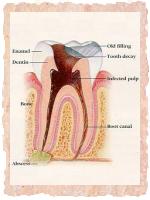|
|
ENDODONTICS
:
Though pain of an odontogenic origin has plagued mankind since the dawn of civilisation, it is only in the past century that the palliative and curative aspects of this subject have assumed the status of being a science on its own. Of the several ramifications of Stomatology, Conservative Dentistry and Endodontics deals with treating and restoring defects of teeth (be it decay, disfigurement, discoloration or the like) to result in proper tooth form, function and aesthetics
we stress mainly on the timely intervention to arrest the process of dental decay and restore the tooth to its form and function with
aes thetic considerations. thetic considerations.
The main procedures done are :
- Restorative procedures with materials like Sliver amalgam
- Tooth coloured restorative materials like ceramic, composite and glass ionomer.
- Single sitting root canal treatment with advanced rotary instruments
- Full crowns for root canal treated prepared in our own state of the ceramic labs.
- Post and core
Root Canals - Endodontics
:
Inside your tooth's hard outer shell is a nourishing pulp of blood vessels, lymph vessels and nerves. The root's canal, allow these vessels and nerves to extend to connect to the rest of the body's systems. Deep tooth decay, or injury can cause serious damage and
infection to the pulps nerves and vessels. Root canal, also known as endodontic treatment, cleans
 out the infected pulp chamber and canals and replaces the organic material with an inert filling. out the infected pulp chamber and canals and replaces the organic material with an inert filling.
Some indications of the need for root canal treatment may be:
Spontaneous pain or throbbing
Pain while biting or chewing
Sensitivity to hot and cold
Severe decay or injury that causes an abscess (infection) in the bone surrounding the tooth
Because the tooth will not heal by itself. Without treatment, infection
w ill spread, bone around the tooth will begin to degenerate, and the tooth may fall out. Pain
usually worsens until one is forced to seek emergency dental attention. The only alternative is
usually extraction of the tooth, which can cause surrounding teeth to shift crookedly, resulting in a
bad bite. Though an extraction is cheaper, the space left behind will require an implant or a bridge, which can be more expensive than root canal therapy. If you have the choice, it's always best to keep your
original teeth. ill spread, bone around the tooth will begin to degenerate, and the tooth may fall out. Pain
usually worsens until one is forced to seek emergency dental attention. The only alternative is
usually extraction of the tooth, which can cause surrounding teeth to shift crookedly, resulting in a
bad bite. Though an extraction is cheaper, the space left behind will require an implant or a bridge, which can be more expensive than root canal therapy. If you have the choice, it's always best to keep your
original teeth.
Treatment usually involves one to four appointments.
More than 95 percent of root canal treatments are successful. However, sometimes a case needs to be retreated. Sometimes a surgical approach is required to seal the canals shut. Occasionally, a root canal therapy will fail altogether, marked by a return of pain, requiring extraction.
|

















